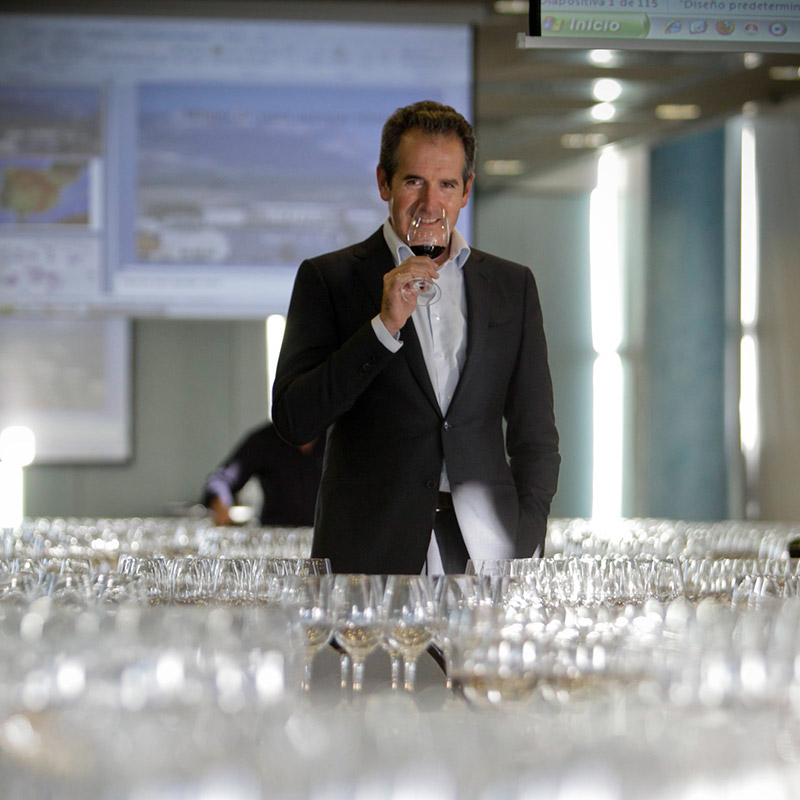 "The devil is in the detail, and the pursuit of excellence means paying attention to all the details." This sentence is an important companion in the creation of the wines of Bodegas Roda in Rioja. This attentiveness goes hand in hand with the basic trust that nature will contribute its part, frankly and unadorned.
"The devil is in the detail, and the pursuit of excellence means paying attention to all the details." This sentence is an important companion in the creation of the wines of Bodegas Roda in Rioja. This attentiveness goes hand in hand with the basic trust that nature will contribute its part, frankly and unadorned.If you consider the many different tasks involved in the production of wine - the individual steps required, from the vine that produces the grapes to the wine that is bottled - this multi-faceted process can be compared to the organic workings of an orchestra: "We work as a team," says Víctor Charcán, Sales Director of Bodegas Roda, to illustrate the intertwining of these different steps in the winemaking process. "If you like, the outstanding figure - our orchestra conductor, so to speak - is Agustín Santolaya, the winemaking and general director of Roda. Isidro Palacios is responsible for viticulture and Carlos Díez de la Concepción is the oenologist." Together with everyone else, the three men live the vision of producing great wines that are accessible at a young age and also have ageing potential. "This has been the guiding principle since our foundation."

It was the vision of Mario Rotllant and Carmen Daurella that laid the foundations for the boutique winery in 1987. The two sold high-quality wines from the renowned wine regions of Bordeaux, Burgundy and Piedmont. But now they wanted to emulate the great houses and believed in the potential of the Rioja terroir. El Barrio de la Estación de Haro is located in the heart of the region, a unique place that captures the essence of Rioja and allows you to travel back in time through centuries of viticulture and winemaking. To do justice to this historical heritage, production is limited, as the winery's focus is clearly on quality. With its first vintage in 1992, Bodegas Roda marked a turning point in the wine community DOCa Rioja, as it once again emphasised the vineyard and worked with minimal intervention in the winery. "We favoured spontaneous fermentation in French oak barrels, malolactic fermentation in barrels and ageing for a maximum of 18 months in French oak barrels, which was a revolution in the 1990s, but is more common today." But it was never just about producing high-quality wines. "Our wines should also tell the story of their place of origin, the climate and the vintage," says Charcán.
This is why the 80-hectare organic winery is also very selective when choosing its vineyards. "We only have bush vines, don't irrigate additionally and maintain the natural plant cover. The foothills of the Obarenes mountains, the meanders of Tondón and the foothills of Monte Toloño are among our best vineyards." It is mainly the red grape variety Tempranillo (more than 80 per cent) that ripens here, followed by Graciano and Garnacha. Only five per cent of the vineyards are planted with white grape varieties such as Viura, Garnacha Blanca and Malvasía. "The predominant soils in the north-west of the DOCa Rioja and the ones we favour are sandstone, poor soils and hilly areas." Only the red grape variety duo Graciano and Garnacha ripen on clay soils. These different elements come together under the watchful eye of a whole orchestra of people who accompany them to create wines "that open a window onto the Rioja landscape that we love so much and that we endeavour to preserve".